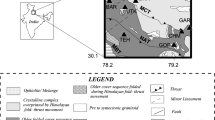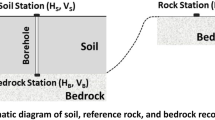Abstract
Site response in and around Delhi is studied using digital seismograms recorded by a thirteen-station VSAT-based 24-bit digital Delhi telemetry network of the India Meteorological Department. Nine local (M l ≥ 2.3) and nine regional (M l ≥ 3.9) earthquakes are selected for the estimation of site amplification factor using the classical standard spectral ratio for regional events (Ridge Delhi Observatory being the reference station), normalized standard spectral ratio for local events, horizontal-to-vertical spectral ratio or receiver function and the generalized inversion techniques in the frequency range of 0.5 to 7.5 Hz. Site response curves at all the thirteen stations exhibit station to station variation of the site amplification factor reflecting the changes in geologic/geotectonic/soil conditions. A comparison of the site response values obtained by the generalized inversion with those computed using receiver function technique shows a large scatter even though the pattern of the curves remain more or less similar. However, the site effects computed by generalized inversion and standard spectral ratio exhibit a good 1:1 correspondence. The peaks yielded by all the methods have been observed to occur at the same frequencies. It is evident that the softer fluvial deposits of the newer alluvium of the east Yamuna sector show steeper site amplification gradient at lower frequencies, while the greater Delhi experiences moderate site amplification. The variation of site response corroborates the abrupt changes in intensity from one location to another due to local site condition.
Similar content being viewed by others
References
Andrews D J 1986 Objective determination of source parameters and similarity of earthquakes of different size;Earthquake Source Mechanics, American Geophysical Union, Washington D.C. 259–268
Avouac J and Tapponnier P 1993 Kinetic model of active deformation in central Asia;Geophys. Res. Lett. 20 895–898
Bilham R, Blume F, Bendick R and Gaur V K 1998 The geodetic constraints on the translation and deformation of India: implications for future great Himalayan earthquakes;Current Science 74 213–229
Bilham R and Gaur V K 2000 The geodetic contribution to the study of seismotectonics in India;Current Science 79 1259–1269
Boatwright J, Fletcher J B and Fumal T E 1991 A general inversion scheme for source, site and propagation characteristics using multiply recorded sets of moderate-sized earthquakes;Bull. Seism. Soc. Am. 81 1754–1782
Borcherdt R D 1970 Effects of local geology on ground motion near San Francisco Bay;Bull. Seism. Soc. Am. 60 29–61
Castro R R, Anderson J G and Singh S K 1990 Site response attenuation and source spectra of S waves along the Guerrero, Mexico, subduction zone;Bull. Seism. Soc. Am. 79 1481–1503
DeMets C, Gordon R G, Argus D F and Stein S 1994 Effect of recent version to the geomagnetism reversal time scale on estimates of current plate motions;Geophys. Res. Lett. 21 2191–2194
Field E H and Jacob K H 1995 A comparison and test of various site response estimation techniques, including three that are not reference site dependent;Bull. Seism. Soc. Am. 85 1127–1143
Field E H, Jacob K H and Hough S H 1992 Earthquake site response estimation: a weak motion case study;Bull. Seism. Soc. Am. 82 2283–2307
Gahalaut V K and Chander R 1997 On interseismic elevation changes and strain accumulation for great thrust earthquakes in the Nepal Himalaya;Geophys. Res. Lett. 24 1011–1014
Gansser A 1964Geology of the Himalayas (New York: Interscience Publ.) 289 pp.
Hartzell S H 1992 Site response estimation from earthquake data;Bull. Seism. Soc. Am. 82 2308–2327
IMD 2000 Chamoli earthquake of March 29, 1999 and its aftershocks;Meteorological Monograph by India Meteorological Department, Seismology No. 2/2000
Khattri K N 1999 An evaluation of earthquakes hazard and risk in northern India;Himalayan Geology 20 1–46
Langston C A 1979 Structure under Mount Rainier, Washington, inferred from teleseismic body waves;J. Geophys. Res. 84 4749–4762
Lermo J F, Francisco S and Chavez-Garcia J 1993 Site effect evaluation using spectral ratios with only one station;Bull. Seism. Soc. Am. 83 1574–1594
Lyon-Caen H and Molner P 1985 Gravity anomalies, flexure of the Indian plate, and structure, support and evolution of the Himalaya and Ganga basin;Tectonics 4 513–538
Menke W 1989 Geophysical data analysis: discrete inverse theory, (New York: Academic)
Molnar P and Chen W P 1982 Seismicity and mountain building, In:Mountain Building Processes, (ed) K Hsu (New York: Academic Press) 41–57
Nath S K, Sengupta P, Sengupta S and Chakrabarti A 2000 Site response estimation using strong motion network: A step towards microzonation of Sikkim Himalayas; Seismology 2000,Current Science 79 1316–1326
Nath S K, Biswas N N, Dravinski M and Papageorgiou A 2002a Determination of S-wave site response in Anchorage, Alaska in the 1–9 Hz frequency band;Pure Appl. Geophysics 159 2673–2698
Nath S K, Sengupta P and Kayal J R 2002b Determination of site response at Garhwal Himalaya from the aftershock sequence of 1999 Chamoli earthquake;Bull. Seism. Soc. Am. 92 1071–1081
Ordaz M and Singh S K 1992 Source spectra attenuation of seismic waves from Mexican earthquakes and evidence of amplification in the hill zone of Mexico City;Bull. Seism. Soc. Am. 82 24–43
Seeber L and Armbruster J G 1981 Great detachment earthquakes along the Himalayan arc and long-term forecasting. In:Earthquake Prediction: An International Review, Maurice Ewing Series, 4, American Geophysical Union, Washington D.C., 259–277
Seekins L C, Wennerberg L, Margheriti L and Liu H P 1996 Site amplification at five locations in San Francisco, California; a comparison of S-waves, codas, and microtremors;Bull. Seism. Soc. Am. 86 627–635
Author information
Authors and Affiliations
Rights and permissions
About this article
Cite this article
Nath, S.K., Sengupta, P., Srivastav, S.K. et al. Estimation of S-wave site response in and around Delhi region from weak motion data. J Earth Syst Sci 112, 441–462 (2003). https://doi.org/10.1007/BF02709271
Issue Date:
DOI: https://doi.org/10.1007/BF02709271




